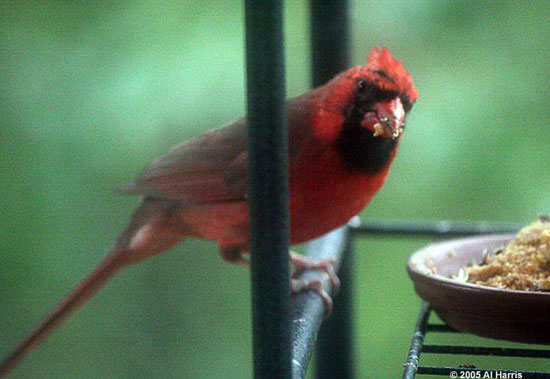 The following is a guest post from 365 member Al Harris. Al has been a member since late 2010 and is well known in the community for his intriguing bird photographs. If you like what you see here you can find out more about Al and see more of his project here.
The following is a guest post from 365 member Al Harris. Al has been a member since late 2010 and is well known in the community for his intriguing bird photographs. If you like what you see here you can find out more about Al and see more of his project here.
As a member of the 365 Project, you probably already have more than enough equipment and skill to capture prize-winning bird photos. Amazingly, for some people the hardest part is to sit still. You can become an outstanding bird photographer without knowing a lot about birds (or even photography!).
My advice falls into four areas.
Roll Out The Welcome Mat
Put food and water in the same place each day and keep the containers well stocked. Bird photography is as simple as putting both food and your camera where you want the birds to appear. I recommend black-oiled sunflower seed and raw peanuts. Sunflower seeds will attract hundreds of birds, including cardinals. Nuthatches, woodpeckers, and titmice seem unable to resist peanuts. In cold weather, suet attracts birds whose natural food sources are depleted or hard to find beneath snow. You can make suet with generic, chunky peanut butter, corn meal, sunflower seeds, and other ingredients such as leftover oatmeal and grits. Sliced fruit and small servings of jam placed in dishes attract particular birds as well. Fresh water is an often-neglected but major attraction.

Finding Good Subjects
You do not need to go anywhere special to find birds. You can install a simple, open-air feeding platform outside a window to give yourself many photo opportunities. Any feeding platform will do, even a plate suspended from a plant hanger. With that approach, you go indoors, pre-focus on a clump of food on the outside platform, and then wait for traffic. For the best quality image, place your lens as close as possible to a clean windowpane. An inexpensive tripod makes the process much easier. Leave your flash turned off to avoid glare.
"Good to Have" Items
A sturdy tripod and a remote shutter release will help you forget about the camera and keep your full attention trained on the birds. Review your camera's user guide to learn which remote will work best. Most any SLR digital camera will be suitable if it enables you to pre-focus (so turn off the auto-focus!) and select a fast shutter speed to stop action. (But do not stop the action completely – motion adds to the interest!) A flash is helpful for reducing contrast in harsh sunlight. Unpleasant contrast occurs when there are deep, dark shadows adjacent to bright highlights. A flash fills in shadows and sharpens details. As you advance in birding, you may want to add additional lenses, particularly a medium zoom lens in the range of 80 to 200mm or greater.

Knowledge
Learning the basics about each species can help you devise strategies for attracting birds; i.e., planting flowers that attract hummingbirds, etc. I find the following books helpful in my particular geographic region: ''Eastern Birds'' published by Peterson Field Guides, ''Field Guide to the Birds of North America'' by National Geographic, and ''Birds of North America'' by the National Wildlife Federation.
Spend a few minutes each day with birds and soon you’ll be capturing great images. Happy birding!

You are a wealth of information and also a terrific photographer. I enjoy you birds everyday.
Having said that the Sunflowers in my garden attracted all sorts of parrots last year, but it was a one off annual event and not a prominent component of their diet.
Thank you Al for your tips and knowledge, this is a cool little article :)
I have a few small trees planted, but they are still too small to be much of a drawing card for my winged friends.
I have no feeders in my garden (have thought about it) but I have still identified over 70 bird species in the 12 months of living here. Birds do take a long time to get used to feeders and bird-baths, and often will prefer the feeder or bath to be in a protected location, especially the smaller birds. Whereas a bigger bird will want a bit more space around the feeder.
I have seen a friend feed Whistling Kites and Kookaburras, and they seemed to prefer to fly in, grab some food and then fly out again.
And your hummingbird photo is gorgeous :)
Hi Al, I just came across this article. I have ordered a bluebird feeder that has a protective wire around it and some mealworms. Any advice on setting out mealworms? That Carolina Wren is still hanging around here. Will he eat them?
THANKS! Can't wait to try it out.
I love that this year has turned me into a birder. It's been one of the greatest joys!